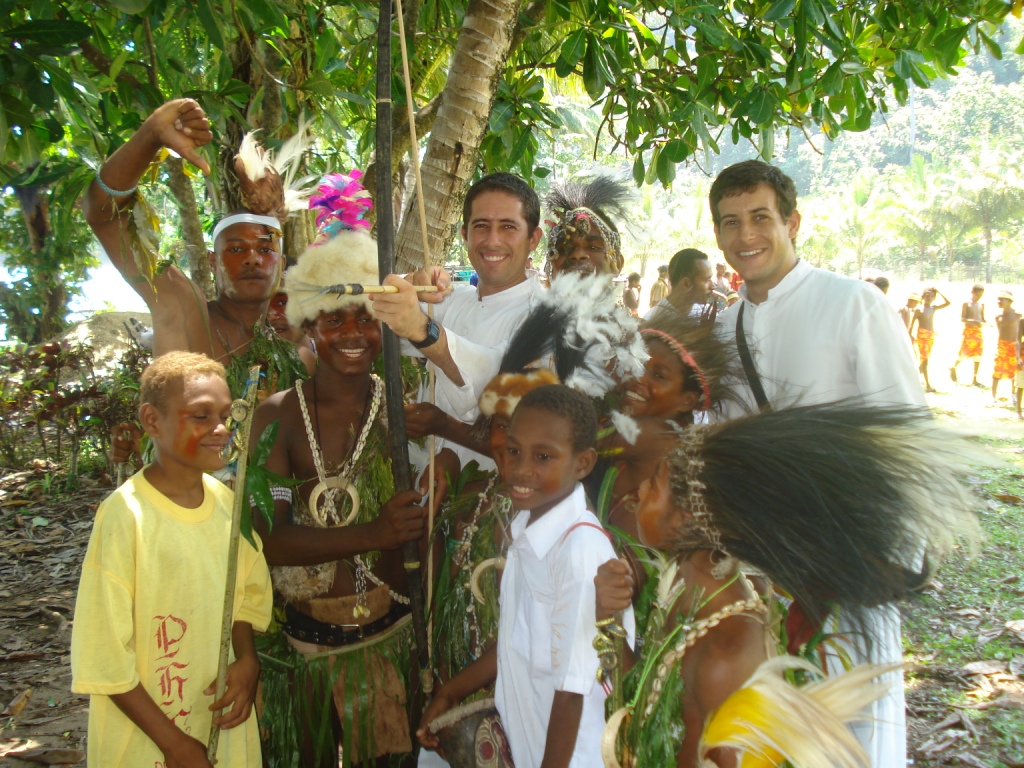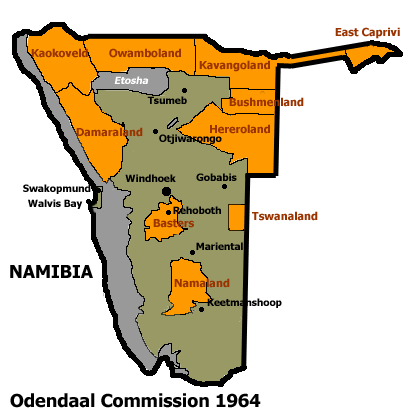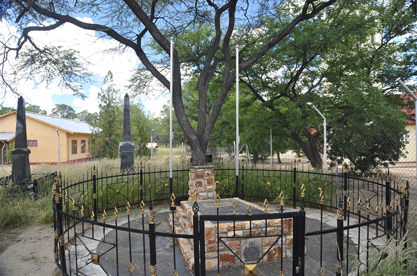|
Amraal Lambert
Amraal Lambert, Nama name: ǂGaiǀnub, (ca. 1774 – 13 February 1864) was the first Captain of the Kaiǀkhauan ( Khauas Nama), a subtribe of the Orlam, in the eastern area of Namaland, today's Namibia. Amraal Lambert was born around 1774 near Hex River in the Clanwilliam district in the Cape Colony (today's South Africa). A Cape Khoikhoi descendant, his status was little better than that of a slave, and he was forced to work in Worcester and Cape Town in his youth. In 1814 Lambert moved to Namaland (today's eastern-central Namibia), accompanied by missionary Heinrich Schmelen, who baptised him in Bethanie in 1815. Schmelen and the Kaiǀkhauan group led by Lambert stayed together for 14 more years but Schmelen closed the missionary station in Bethanie in 1822 and travelled on. Lambert accompanied Schmelen on his travel to Walvis Bay in 1825. Between 1830 and 1860, Amraal Lambert and his cousin Jonker Afrikaner controlled much of southern and central South-West Africa. Toge ... [...More Info...] [...Related Items...] OR: [Wikipedia] [Google] [Baidu] |
Traditional Leader
A tradition is a system of beliefs or behaviors (folk custom) passed down within a group of people or society with symbolic meaning or special significance with origins in the past. A component of cultural expressions and folklore, common examples include holidays or impractical but socially meaningful clothes (like lawyers' wigs or military officers' spurs), but the idea has also been applied to social norms and behaviors such as greetings, etc. Traditions can persist and evolve for thousands of years— the word ''tradition'' itself derives from the Latin word ''tradere'' literally meaning to transmit, to hand over, to give for safekeeping. While it is reportedly assumed that traditions have an ancient history, many traditions have been invented on purpose, whether it be political or cultural, over short periods of time. Various academic disciplines also use the word in a variety of ways. The phrase "according to tradition" or "by tradition" usually means that what follows i ... [...More Info...] [...Related Items...] OR: [Wikipedia] [Google] [Baidu] |
Missionary
A missionary is a member of a Religious denomination, religious group who is sent into an area in order to promote its faith or provide services to people, such as education, literacy, social justice, health care, and economic development.Thomas Hale 'On Being a Missionary' 2003, William Carey Library Pub, . In the Bible translations into Latin, Latin translation of the Bible, Jesus, Jesus Christ says the word when he sends the disciples into areas and commands them to preach the gospel in his name. The term is most commonly used in reference to Christian missions, but it can also be used in reference to any creed or ideology. The word ''mission'' originated in 1598 when Jesuits, the members of the Society of Jesus sent members abroad, derived from the Latin (nominative case, nom. ), meaning 'act of sending' or , meaning 'to send'. By religion Buddhist missions The first Buddhist missionaries were called "Dharma Bhanaks", and some see a missionary charge in the symbolism ... [...More Info...] [...Related Items...] OR: [Wikipedia] [Google] [Baidu] |
Smallpox
Smallpox was an infectious disease caused by Variola virus (often called Smallpox virus), which belongs to the genus '' Orthopoxvirus''. The last naturally occurring case was diagnosed in October 1977, and the World Health Organization (WHO) certified the global eradication of the disease in 1980, making smallpox the only human disease to have been eradicated to date. The initial symptoms of the disease included fever and vomiting. This was followed by formation of ulcers in the mouth and a skin rash. Over a number of days, the skin rash turned into the characteristic fluid-filled blisters with a dent in the center. The bumps then scabbed over and fell off, leaving scars. The disease was transmitted from one person to another primarily through prolonged face-to-face contact with an infected person or rarely via contaminated objects. Prevention was achieved mainly through the smallpox vaccine. Once the disease had developed, certain antiviral medications could poten ... [...More Info...] [...Related Items...] OR: [Wikipedia] [Google] [Baidu] |
Khoikhoi Language
Khoekhoe or Khoikhoi ( ; , ), also known by the ethnic terms Nama ( ; ''Namagowab''), Damara (''ǂNūkhoegowab''), or Nama/Damara and formerly as Hottentot, is the most widespread of the non-Bantu languages of Southern Africa that make heavy use of click consonants and therefore were formerly classified as Khoisan, a grouping now recognized as obsolete. It belongs to the Khoe language family, and is spoken in Namibia, Botswana, and South Africa primarily by three ethnic groups: Namakhoen, ǂNūkhoen, and Haiǁomkhoen. History The Haiǁom, who had spoken a Juu language, later shifted to Khoekhoe. The name for the speakers, ''Khoekhoen'', is from the word ''khoe'' "person", with reduplication and the suffix ''-n'' to indicate the general plural. Georg Friedrich Wreede was the first European to study the language, after arriving in ǁHui!gaeb (later Cape Town) in 1659. Status Khoekhoe is a national language in Namibia. In Namibia and South Africa, state-owned broadcasting ... [...More Info...] [...Related Items...] OR: [Wikipedia] [Google] [Baidu] |
Afrikaans
Afrikaans is a West Germanic languages, West Germanic language spoken in South Africa, Namibia and to a lesser extent Botswana, Zambia, Zimbabwe and also Argentina where there is a group in Sarmiento, Chubut, Sarmiento that speaks the Patagonian Afrikaans, Patagonian dialect. It evolved from the Dutch language, Dutch vernacular of South Holland (Hollandic dialect) spoken by the free Burghers, predominantly Dutch settlers and slavery in South Africa#Dutch rule, enslaved population of the Dutch Cape Colony, where it gradually began to develop distinguishing characteristics in the 17th and 18th centuries. Although Afrikaans has adopted words from other languages including German language, German, Malay language, Malay and Khoisan languages, an estimated 90 to 95% of the vocabulary of Afrikaans is of Dutch origin. Differences between Afrikaans and Dutch often lie in the more analytic language, analytic Morphology (linguistics), morphology and grammar of Afrikaans, and differ ... [...More Info...] [...Related Items...] OR: [Wikipedia] [Google] [Baidu] |
Red Nation (tribe)
The Red Nation () is the main subtribe of the Nama people in Namibia and the oldest Nama group speaking Khoekhoegowab, the language often called Damara/Nama. The main settlement of the Red Nation is Hoachanas, a small settlement in southern central Namibia, today part of the Hardap Region. History Pre–colonial period The word ''Khaiǁkhaun'' means "great defender" in Khoekhoe, from ǁkhau, "defend". There is no agreement as to where the name ''Red Nation'' originated from. Heinrich Vedder claims that the Khaiǁkhaun called themselves ǀAwa-khoi, "red people", whereas Klaus Dierks declares that the Europeans later nicknamed the tribe ''Red Nation''. In any case, the attribution is a reference to their slightly reddish face color. The first Kaptein of the Khaiǁkhaun was ǂHâb who unified most of the Nama clans at the end of the 17th century. After ǂHâb's death in 1710 the ǁKhauǀgoan (Swartbooi Nama) and the ǂKharoǃoan (Keetmanshoop Nama) were the first Nama groups to ... [...More Info...] [...Related Items...] OR: [Wikipedia] [Google] [Baidu] |
Leonardville, Namibia
Leonardville is a village in eastern Namibia, situated on the Nossob River in the south-western corner of the Omaheke Region. It belongs to the Aminuis electoral constituency. It had a population of 2,099 people in 2023. Leonardville was the main settlement of the Khaiǁkhaun (Khauas Nama) subtribe of the Oorlam people until their military defeat against Imperial Germany's ''Schutztruppe'' soldiers in 1894 and 1896. History The area around Leonardville was inhabited by the Taa-speaking subtribe of the San people until the Khaiǁkhaun (Red Nation), who called the place ''Naosanabis'', occupied their land. Around 1840, the group around Amraal Lambert, first Kaptein of the Kaiǀkhauan Orlam, moved into the area. They had been granted residence and pasture in the land of the Red Nation at an annual fee. In 1843, the Wesleyan Missionary Society established a missionary station here; its first missionaries were Joseph Tindall and his son Henry. They named the settlement ''Wes ... [...More Info...] [...Related Items...] OR: [Wikipedia] [Google] [Baidu] |
Damaraland
Damaraland was a name given to the north-central part of South West Africa, which later became Namibia, inhabited by the Damaras. It was bordered roughly by Ovamboland in the north, the Namib Desert in the west, the Kalahari Desert in the east, and the Windhoek region in the south. Administrative history Bantustan In the 1970s the name Damaraland was chosen for a Bantustan, intended by the apartheid-era government to be a self-governing homeland for the Damara people. The Bantustan Damaraland was situated on the western edge of the territory that had been known as Damaraland in the 19th century. Representative authority (1980–1989) Following the Turnhalle Constitutional Conference the system of Bantustans was replaced in 1980 by Representative Authorities which functioned on the basis of ethnicity only and were no longer based on geographically defined areas. The Representative Authority of the Damaras had executive and legislative competencies, being made up of electe ... [...More Info...] [...Related Items...] OR: [Wikipedia] [Google] [Baidu] |
New Era (Namibia)
The ''New Era'' is a daily national newspaper owned by the government of Namibia. The newspaper is one of four daily national newspapers in the country, the others being ''The Namibian'' (English and Oshiwambo), '' Die Republikein'' (Afrikaans) and '' Allgemeine Zeitung'' ( German). ''New Era'' was created by the ''New Era Publications Corporation Act of 1992''. According to Ullamaija Kivikuru, it copied the format of ''The Namibian'' in order to establish credibility. The two newspapers still resemble each other in having long stories spread over several pages. ''New Era'' has a usual circulation of 9,000, going up to 11,000 on Fridays.Rothe, ''Media System and News Selections in Namibia'', p. 23. It was established as a weekly newspaper and was later published only bi-weekly. It has appeared daily since 2004. ''New Era'' is published in English and five indigenous languages: Otjiherero, Oshiwambo, Damara/Nama, Silozi, and Khwedam. ''New Era'' is published by the New Era ... [...More Info...] [...Related Items...] OR: [Wikipedia] [Google] [Baidu] |
Jonker Afrikaner
Jonker Afrikaner (3 February 1785, 18 August 1861, Okahandja) was the fourth Captain of the Orlam in South West Africa, succeeding his father, Jager Afrikaner, in 1823. Soon after becoming ''Kaptein'', he left his father's settlement at Blydeverwacht with three brothers and some 300 followers and relocated to the area that is today central Namibia. From 1825 onwards he and his council played a dominant political role in Damaraland and Namaland, creating a '' de facto'' state. Around 1840, he established a settlement at Windhoek where he built a church for a congregation of between 500 and 600 in the area of the present-day Klein Windhoek suburb. He is further known for his road-building activities in central and southern Namibia, particularly the one over the Auas Mountains to the south and the northern Bay Road from Windhoek to Walvis Bay Walvis Bay (; ; ) is a city in Namibia and the name of the bay on which it lies. It is the List of cities in Namibia, second lar ... [...More Info...] [...Related Items...] OR: [Wikipedia] [Google] [Baidu] |





